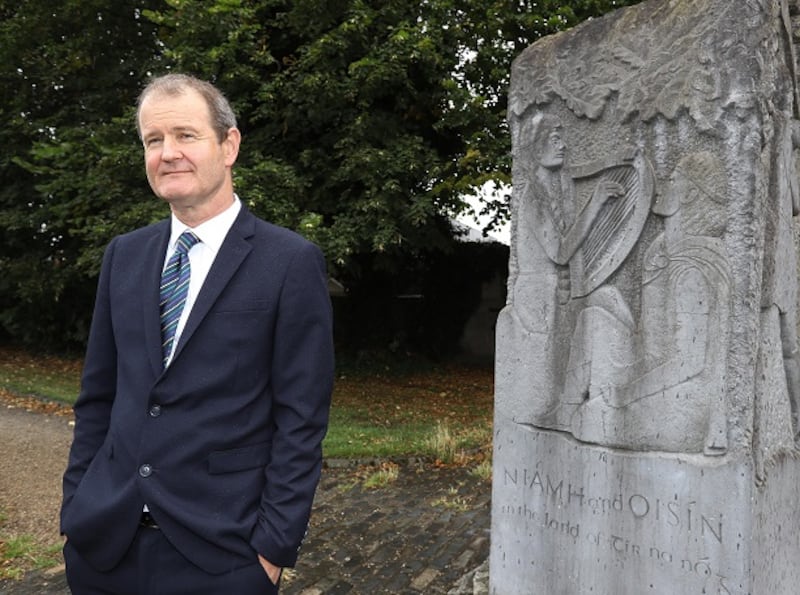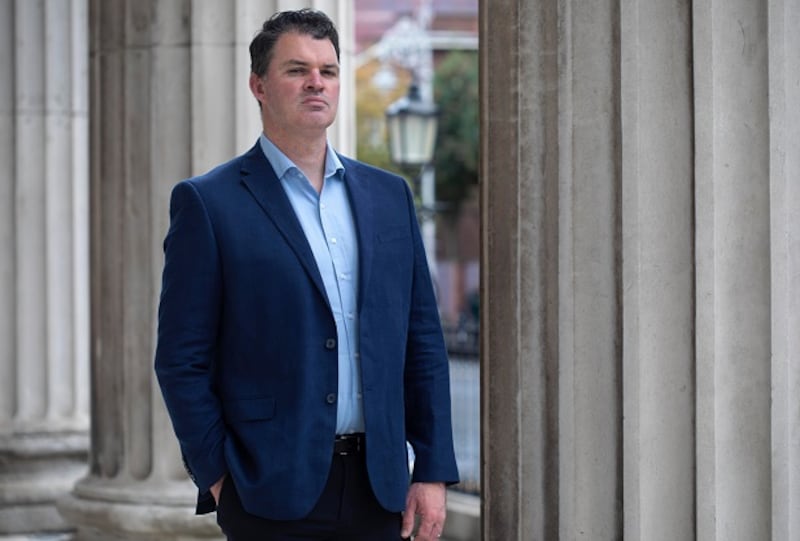Children and adolescents seeking help for a mental health crisis are ending up in the emergency departments of paediatric hospitals in ever-increasing numbers.
Attendances at emergency departments for mental health issues jumped by 58 per cent (514 to 810) over the second half of 2020, compared with the same period the previous year, according to figures supplied by Children’s Health Ireland (CHI), which oversees acute paediatric hospital services. Admissions for children and adolescents with eating disorders have also escalated, with a 66 per cent increase in admissions to CHI hospitals in the first three months of this year, compared with the same period last year.
Yet, officially, mental health services don’t operate in these hospitals. While some of these children need medical treatment for a physical consequence of their mental condition, the rest are in the “wrong”place and going under the radar.
Even before Covid-19, the children's hospitals here were raising red flags over the risks they take in admitting youngsters with mental health conditions to general paediatric wards
None of these hospitals are "approved centres" for inpatient mental health care, under the watchful eye of the Mental Health Commission. Nor are they part of the Health Service Executive's Child and Adolescent Mental Health Services, which are delivered both in the community and through specialist inpatient units.
But families are going to emergency departments in desperation because there is nowhere else to go with their distressed children. Child and Adolescent Mental Health Services doesn’t operate out of hours; “emergency slots” during the day are very limited or non-existent; and waiting lists are long.
Suicidal ideation, self-harm thoughts and self-harming acts, as well as anxiety and behavioural issues, are the most common issues being seen in emergency departments. It is a trend in keeping with what other paediatric hospitals internationally are reporting, according to the CHI, in looking at the impact of the pandemic on children and children’s services.
A sharp drop in all attendances at Children’s Health Ireland emergency departments during the first months of the 2020 lockdown preceded the surge in the second half of the year. However, while overall emergency department attendance in the Dublin paediatric hospitals during the 12 months to the end of February 2021 was 34.3 per cent below the prior year, those presenting with mental health issues were 8.9 per cent up, according to a study led by University College Dublin and published in the Irish Medical Journal.
Even before Covid-19, the children’s hospitals here were raising red flags over the risks they take in admitting youngsters with mental health conditions to general paediatric wards. There are dangers not only to those patients themselves who, in CHI’s words, “are receiving less than optimum care in an unacceptable clinical environment”, but also to staff, who have been stressed and injured, and there are knock-on effects for other patients too.
“The impact of treating these children – who require care for their mental health illness but not other medical care – in a suboptimal environment results in poorer outcomes for children and adolescents with mental health issues and also compromises the care of children who are receiving other forms of treatment at the same time,” warned the Children’s Health Ireland in its 2019 annual report.
None of these children are counted by the Mental Health Commission, which logs every admission of a child or adolescent to approved centres. The commission notes in its 2020 annual report that, as there are Child and Adolescent Mental Health Services units in only three counties and they generally don’t take out-of-hours admissions, “children and young people in crisis are left with the unacceptable ‘choice’ between an emergency department, general hospital, children’s hospital or an adult inpatient unit”.
The default is not 'no, we can't help' or 'we have a five-year waiting list'; the default is 'we do our best'
Although the Mental Health Commission has no regulatory responsibilities for what goes on in paediatric or general hospitals, it says it has sought further information on the number and length of admissions to children’s hospitals for children with a primary presentation of a mental health illness or disorder; the policy or protocol for children in need of out-of-hours admission; and the policy or protocol for referrals to Child and Adolescent Mental Health Services inpatient services.
"We have raised our concern that admissions to children's hospitals for the treatment of a mental illness or disorder are not safe, appropriate or in compliance with the provisions of the Mental Health Act 2001," John Farrelly, chief executive of the Mental Health Commission, told The Irish Times.
Yet the young patients keep arriving and liaison psychiatry services on the frontline of clinical care in children’s hospitals must deal with whatever comes in the door. Their job may be chiefly to treat psychiatric dimensions to physical illness, for example, a cancer patient who is also suffering from depression, or look after medical cases with co-existing mental health disorders such as ADHD, but they are swamped by those for whom mental health is the primary problem.
In numbers
10,814
Number on primary care psychology waiting lists, most of whom are under 18
€4 million
Injection of funds announced in August to address psychology waiting times
2,885
Number on waiting lists for Child and Adolescent Mental Health Services
78.6 per cent
Percentage of referrals offered an appointment within 12 weeks
1,550
Number waiting less than three months for an appointment
279
Number waiting more than a year for a Child and Adolescent Mental Health Services appointment
Two out of eight
Number of multidisciplinary Child and Adolescent Mental Health Services teams planned under the 2018 National Clinical Programme for Eating Disorders that are now operating, providing assessment and treatment in the community
Source: HSE press office
It's this "underbelly" of the children's mental health service that they argue must be named, counted and then resourced – either within hospitals or elsewhere. In the absence of mental health services funding for this care, we need to stop pretending it isn't existing in hospitals, argues Dr Kieran Moore, consultant child psychiatrist with Children's Health Ireland at Crumlin.
“The vast majority of our work is patients sent in through A&E and so much of that is ringing, liaising, trying to get other services involved, which is kind of ridiculous for us to be doing.”

These children are “absolutely going under the radar”, says Dr Ian McClelland, a liaison psychiatrist with Children’s Health Ireland at Temple Street for the past four years. “They are not counted because we’re a non-Mental Health Commission hospital, with all kinds of things that you can hurt yourself with.” In other words, the hospital is not safety-proofed to the level of approved centres.
He notes wryly the consternation that always greets the annual recording of nights spent by teenagers in adult inpatient units (this figure was down to 23 in the Mental Health Commission’s report for 2020). “It shouldn’t happen,” he acknowledges, “but I just find how it is funny that the narrative gets skewed that this is the worst thing to ever happen.
“There are much worse things than that in my view, including absolute chaos on paediatric wards, putting other kids at risk because of what that kid presented with, compared to a 16 year old on an adult ward with two members of staff with them at all times.
“People who condemn that need to come and spend a week with a liaison team and see what comes in our door,” he says.
McClelland and Moore argue health policy-makers need to take stock and find a better way of doing things that would benefit distressed children and their families. Besides, an acute hospital bed is an expensive place of last resort.
McClelland talks of up to a dozen or so mental health patients who have got “stuck” in Temple Street for months on end, being treated for anorexia or awaiting placement because they have a disability or are “risky” and either can’t go home because the family can’t cope or they are waiting for a psychiatric inpatient bed.
The Child and Adolescent Mental Health Services inpatient units will often say the profile of a child is too severe for them, too dangerous, they’re not taking them, says Moore.
There is no sign of that stream of referrals from GPs slowing down anytime soon
“And you’re left with a child in a paediatric hospital who may be very ‘behaviourally disturbed’ and on some occasions can be violent – although that is in a minority – beside a child in an orthopaedic ward who has just had a fractured bone from another cause. The mismatch there is unbelievable, and it is not said.”
To try to keep an aggressive teenager and non-specialist nursing staff safe in a ward that is not built for such patients, with breakable glass for instance, “the risks are huge”, he says. “It’s the madness of what we’re doing.”
Yet the hospitals’ sense of duty of care means they look after these children and always find a bed if necessary.
“The default is not ‘no, we can’t help’ or ‘we have a five-year waiting list’; the default is ‘we do our best’, and I think that could happen elsewhere,” Moore says pointedly.
McClelland, who worked with an inpatient psychiatric unit for several years, finds the cohort of patients they have in Temple Street are often significantly more challenging.
“I could pick and choose what comes into an inpatient unit. Whereas here we have to admit anyone who is risky because we can’t send anyone away.”
Child and adolescent mental health is complex, both in nature and in the structures that have been developed outside the acute hospitals to try to cope with increasing demand in this area. But with every strand of these services – primary care psychology, Child and Adolescent Mental Health Services, disability teams – having long waiting lists and set criteria on who they will and will not see, McClelland doesn’t blame general practitioners for reckoning that the “path of least resistance is to the emergency department”.

Family doctors can also be assured, he says, that their patients will get “an incredibly thorough assessment” at the hospital before, in many cases, being referred back to Child and Adolescent Mental Health Services. However, hospital psychiatrists find it frustrating that not only must they fill in lengthy, time-consuming forms for such referrals but also they are powerless over when, or indeed whether, Child and Adolescent Mental Health Services will see those patients.
People can end up on waiting lists because a referral is deemed appropriate but not a priority, says McClelland. But after waiting for weeks, they come back into Temple Street “and we send another referral”.
Such patients receive more intensive therapy in hospital than they will in Child and Adolescent Mental Health Services, which can be another reason for “frequent attendees”, he says. “Why would you not want to return to that place of comfort if you’re in distress?”
He acknowledges that GPs are holding a lot of responsibility in regards to children with mental health issues, and that it is very hard to risk-assess these youngsters.
“We know self-harm is a risk factor for suicidal acts but working out which ones are going to go on to do that is very difficult. Most of the very significant self-harm or suicidal acts that come into Temple Street aren’t known to anyone. That is my clinical experience.
We are sending kids home; you're taking a risk to send a kid home
“There is no sign of that stream of referrals from GPs slowing down anytime soon,” he continues. “There needs to be other, non-Cahms related services to mop up some of this tidal wave really.”
He believes one answer could be off-site specialist hubs that would cater for the many youngsters who present with self-harm or suicidal thoughts but “haven’t actually done anything”. These could take referrals from GPs, schools and even walk-ins, he suggests, while hospitals focus on those where medical treatment is required after, say, an overdose or some other physical injury.
While “the ‘wellbeing’ world is very big,” says McClelland, and attracting a lot of attention, “that is not seeing the spikey end of suicidal thoughts in young girls. We are ploughing along, dealing with the most risky kids, yet there is no PR behind paediatric hospitals.”
He would hold that emergency work is everybody’s work and that mental health care is too disjointed. “Everyone has got their own agenda, with different things driving that agenda.”
McClelland says he was negative about Child and Adolescent Mental Health Services, even when he worked there in the past, as did Moore. “It’s very hard to get people to change work practices. They are worried if they start to do longer hours, or Sunday mornings, it’s the slippery slope and they are already overwhelmed.”
With all the other mental health services saying “not us”, children are coming to hospitals, “so they are ‘us’ for us”, says Moore. “Can we not do it a different way?”
It’s not all doom and gloom, he stresses, but quality research is needed on patients’ needs and experiences to inform much-needed improvements. Get the Mental Health Commission involved and those improvements might have to be on health and safety grounds, he suggests.
There are plans for an “approved centre” at the new children’s hospital, he says, but as this inpatient unit will be under mental health services and not the hospital management, “there will be no free flow between the two of them”.
Working within an unsatisfactory and stressed system is not good for clinicians either and McClelland says it has been a factor in his decision to leave Temple Street this August. He is taking up a locum post in child and adolescent services at the independent St Patrick’s Mental Health Services.
It is very hard not to get burnt out, he says frankly, seeing hundreds of patients a year, “without any safety nets”. In Temple Street he has had a much higher caseload than his Child and Adolescent Mental Health Services colleagues, who do have a safety net, he points out, as “they can always say ‘go to the hospital’. We are sending kids home; you’re taking a risk to send a kid home.”
The only alternative is to admit everyone, which would be “politically and logistically a nightmare”.
McClelland knows systemic change is needed, but meanwhile, with “the ultimate fear of a teenager or younger person being missed, a 24/7 service is where you are going to send someone”. And so they keep coming.
If you are affected by issues in this article and need to seek help, contact YourMentalHealth on 1800 111 888 or Samaritans on 116 123




















